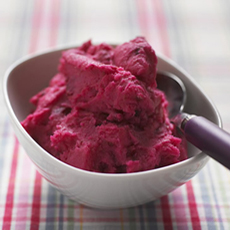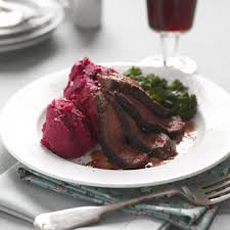|
THE HISTORY OF BEETS
Beets, Beta vulgaris are a root vegetable: leaves grow above ground, and the edible root is below. In America, the shortened form, beet, is used instead of the longer beetroot.
Beets evolved from wild sea beet, which grew in places as wide-ranging as Britain and India. It was first cultivated in the eastern Mediterranean and Middle East—although only the leaves were eaten. (Even today, beet greens are delicious. Don’t throw them away: Sauté them in olive oil with some minced garlic.)
Roman recipes included cooking beets with honey and wine. Apicius, the renowned Roman gourmet, included a beet broth recipe in his cookbook as well as beet salad with a dressing of mustard, oil and vinegar. All are still fine recipes today.
The original beet roots were long and thin like carrots. The rounded root shape of today was developed in the 16th century; by the 18th century it was widely cultivated in central and eastern Europe. Many of today’s classic beet dishes originated in this region, including borscht.
In 19th century England, beets’ dramatic color were often used to brighten up salads and soups. The high sugar content made it a popular ingredient in cakes and puddings (and in the U.S., led to the creation of red velvet cake).
Today there are many varieties of beets sizes large and small, including candy-striped (with red and white concentric circles), orange, white and yellow. Look for these specialty beets in farmers markets.
BEET TIPS
You can use cooked beets in any recipe that requires raw beets. Just reduce the cooking time accordingly.
Alas, beet juice does stain. If you aren’t a very neat cook or eater, wear dark clothing! But beet juice is a water-soluble dye, so try one of these methods to clean up stains:
To remove from hands, rub with lemon juice and salt before washing with soap and water.
To remove from fabric, rub a slice of raw pear on the stain before washing or rinse in cold water before washing in detergent.
For cutting boards and containers, use a bleach solution.
|




